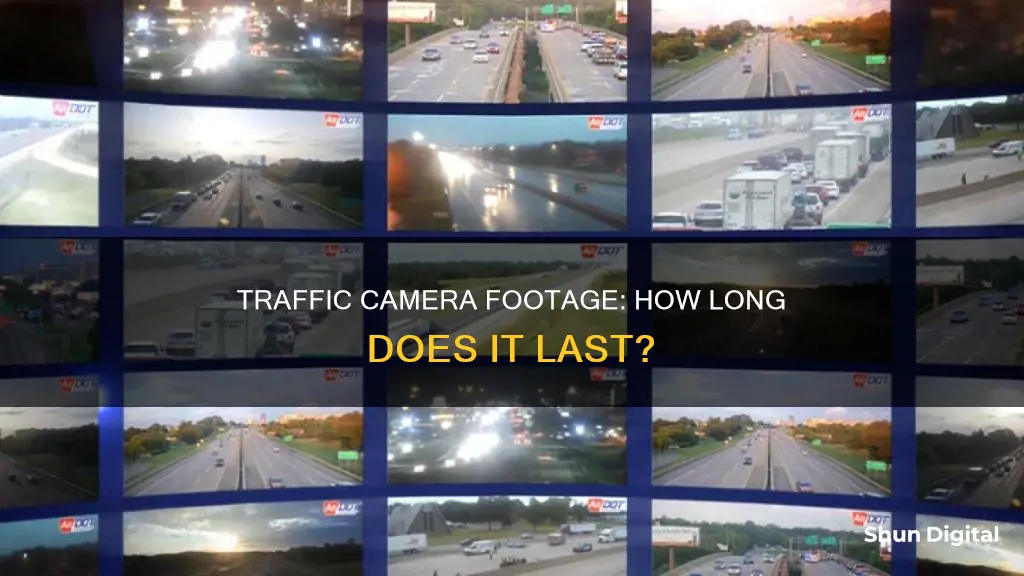
Traffic camera footage is an invaluable piece of evidence in car accident cases. It can be used to determine the cause of the accident, verify accounts of events, and establish liability. However, obtaining this footage can be challenging and time-consuming. The duration for which the footage is stored varies depending on the jurisdiction and the specific camera system in use. Most traffic camera systems will generally record and store footage from a few days to several weeks, but this can range from 24 hours to five years. In some cases, the footage may be kept indefinitely if it is needed for an ongoing investigation or legal proceeding. It is important to act quickly to obtain the desired footage as it is usually not recoverable once deleted or overwritten.
| Characteristics | Values |
|---|---|
| Duration of storage | 30-90 days, depending on the jurisdiction |
| Factors affecting storage duration | Type of violation, location of the camera, whether a violation was detected |
| Jurisdictional requirements | Varies across different locations |
| Purpose of recording | Monitoring traffic flow, detecting violations, investigating accidents |
| Retrieval process | Identify camera location and jurisdiction, contact the appropriate agency, request the footage, review the footage, seek legal advice if needed |
| Storage technology | Hard drives, solid-state drives, cloud-based storage solutions |
| Data protection regulations | GDPR in the European Union, limiting data retention unless a legitimate reason exists |
| Privacy concerns | Risk of abuse or misuse of personal information, addressed through encryption and access controls |
| Impact on investigations | Longer retention periods may increase data review time and costs during investigations |
| Average storage duration | A few days to several weeks, some systems store for months or years |
| FOIA requests | Applicable in some locations, recommended to act quickly |
What You'll Learn

Traffic camera footage retention periods vary by location
The retention period for traffic camera footage varies depending on the location. In Chicago, 24-hour streaming video from red light cameras is available for 30 days, while red-light violation footage can be viewed for up to two years. In New York City, the Department of Transportation stores traffic camera footage for 30 days, while in Los Angeles, California, traffic camera footage is kept for up to five years. In some cases, the footage may be kept indefinitely if needed for an ongoing investigation or legal proceeding.
The storage duration of traffic camera footage depends on the policies set by local authorities and the specific camera system in use. Most traffic camera systems record and store footage from a few days to several weeks, but some systems store footage for longer periods, ranging from several months to years. The type of traffic camera also plays a role, with enforcement cameras used to catch traffic violations typically storing footage for shorter periods than non-enforcement cameras that monitor road conditions in real time.
The process of obtaining traffic camera footage can be complex and time-consuming, and it is recommended to act quickly as some agencies may overwrite or delete footage within 24 to 72 hours. In most cases, a Freedom of Information Act (FOIA) request must be submitted to the relevant government agency, which can be the local police department, the Department of Transportation, or a private company. Some agencies may require a subpoena or a privacy release form, and there may be a small fee associated with the request.
Battery Saver Mode: Impact on Camera Performance
You may want to see also

Retention periods range from days to years
The retention period for traffic camera footage varies depending on the location and the purpose for which the footage was recorded. In general, most jurisdictions keep the footage for 30 to 90 days before it is deleted or overwritten. However, retention periods can range from as little as 24 hours to several months or even years.
For example, in New York City, the Department of Transportation stores traffic camera footage for 30 days before deleting it, while in Los Angeles, California, traffic camera footage is kept for up to five years. The variation in retention periods is due to the different storage technologies used and the policies set by local authorities.
Some systems utilise hard drives or solid-state drives with limited storage capacities, requiring frequent deletion or overwriting of old data. Others employ cloud-based storage solutions, offering virtually unlimited storage capacity. The type of violation being monitored, the location of the camera, and whether a violation was detected also influence the retention duration.
It is worth noting that there are no federal laws governing the retention of traffic camera footage, but some states and municipalities have specific regulations. For instance, in California, red light camera footage must be retained for at least 30 days, while in New York City, speed camera footage must be deleted after 60 days unless needed as evidence.
The purpose of the footage also impacts the retention period. If the footage is required for an ongoing investigation or legal proceeding, it may be kept indefinitely. However, if it is for routine traffic monitoring, it may only be stored for a short period.
The lack of standardised retention policies for traffic camera footage can create confusion, and it is essential to act quickly when requesting footage, as once it is deleted or overwritten, it is typically irrecoverable.
Understanding Simple Focus Cameras and Their Unique Functionality
You may want to see also

In some places, footage is kept indefinitely
The duration for which traffic camera footage is stored varies from one jurisdiction to another. In most cases, the footage is kept for a period of 24 hours to 90 days before it is deleted or overwritten. However, in some places, traffic camera footage is kept indefinitely.
For example, in Los Angeles, California, traffic camera footage is stored for up to five years. On the other hand, in New York City, the Department of Transportation stores traffic camera footage for only 30 days before deletion. The storage duration depends on the policies set by local authorities and the specific camera system in use.
The length of time traffic camera footage is retained can also be influenced by the storage technology employed. Systems using hard drives or solid-state drives may require frequent deletion or overwriting due to limited storage capacities. In contrast, cloud-based storage solutions offer virtually unlimited storage capacity, allowing for longer retention periods.
It is worth noting that the longer the footage is stored, the greater the risk of privacy violations and misuse of personal information. To address these concerns, some jurisdictions have implemented data protection regulations, such as the European Union's GDPR, which mandates the deletion of personal data after a certain period unless there is a legitimate reason for retention.
In the context of traffic camera footage kept indefinitely, this typically applies to cases where the footage is needed for ongoing investigations or legal proceedings. For instance, if the footage captures a traffic violation or is required as evidence in a court case, it may be retained indefinitely.
Additionally, advancements in technology will likely impact how long traffic camera footage can be stored in the future. Improvements in storage technology may enable longer retention periods, while artificial intelligence algorithms may automate the analysis of footage, reducing the need for manual review.
In summary, while the majority of jurisdictions retain traffic camera footage for a limited duration, there are instances where footage is kept indefinitely, usually pertaining to ongoing investigations or legal proceedings.
Concealing Surveillance Cameras: Outdoor Strategies for Privacy
You may want to see also

Jurisdictions with longer retention periods may face higher privacy violation risks
Jurisdictions with longer retention periods for traffic camera footage may face higher privacy violation risks. The duration of storage for traffic camera footage varies across jurisdictions, typically ranging from 24 hours to 90 days. However, some jurisdictions, like Los Angeles, California, retain footage for up to five years. The lack of standardized retention periods across different areas contributes to this risk.
The longer retention of footage increases the chances of personal information misuse or abuse. This is a significant concern, as traffic cameras capture license plates and monitor traffic flow, containing sensitive data. Jurisdictions with extended retention periods provide more opportunities for unauthorized access and misuse of this data.
To mitigate these risks, some jurisdictions have implemented data protection regulations, such as the European Union's GDPR, which mandates the deletion of personal data after a certain period unless there is a valid reason for retention. Encryption and access controls are also employed to safeguard information.
Additionally, technological advancements will impact how long traffic camera footage can be stored in the future. Improved storage technologies and artificial intelligence algorithms will enable longer retention periods without frequent data deletion. Therefore, it is crucial for policymakers and law enforcement agencies to continuously evaluate and address privacy risks associated with extended retention periods.
Choosing a Camera: Capturing Nature and Cars
You may want to see also

Requesting footage can be a complex process
Requesting traffic camera footage can be a complex and frustrating process. The procedure varies depending on the location and the organisation in charge of the camera. Here are some general guidelines to help you navigate the process:
Identify the Camera Location and Jurisdiction
First, you need to identify the location of the traffic camera that may have captured the incident. You can do this by reviewing police reports or contacting the local police department or department of transportation. Once you've found the camera's location, determine whether it is operated by the local authorities or a private company, as this will dictate who you need to contact to obtain the footage.
Contact the Appropriate Agency
After identifying the camera's jurisdiction, contact the relevant agency to request the footage. This may be the local police, department of transportation, or a private company. Provide as much information as possible about the incident, including the date, time, and location. Be persistent but polite in your follow-up calls or emails.
Understand the Retention Policies
Different types of traffic cameras have varying retention periods for their footage. For example, in the UK, CCTV camera footage is typically retained for around 31 days, while speed camera footage is kept for a similar period, and red light camera footage is usually stored for 14 days. However, these are just guidelines, and the retention period may be longer or shorter depending on the circumstances and the agency's policies. Some agencies may only keep footage for a few days, while others may store it for several months or even years. Therefore, it is crucial to act quickly when requesting footage, as once it has been deleted or recorded over, it is usually unrecoverable.
Be Aware of Data Protection Laws
The retention and release of traffic camera footage are subject to strict data protection laws, such as the General Data Protection Regulation (GDPR) in the European Union. These laws ensure that personal data is handled securely and responsibly. As a result, agencies may have restrictions on releasing footage to the public, especially if it contains sensitive information about other individuals.
Seek Legal Advice if Necessary
If you are unsure about how to proceed or encounter difficulties in obtaining the footage, consider seeking legal advice from a specialist lawyer or advocate. They can guide you through the process, protect your rights, and help you use the footage effectively to support any legal claims.
The Sweet Journey: Chocolate's On-Camera Making
You may want to see also
Frequently asked questions
The process of obtaining traffic camera footage can be complex and frustrating and time-consuming. It involves several steps, including identifying the camera's location and jurisdiction, contacting the appropriate agency, and submitting a formal request. The entire process can take several days or even weeks.
The duration of storage for traffic camera footage varies depending on the jurisdiction and the specific camera system. In general, most jurisdictions retain footage for 30 to 90 days before deletion or overwriting. However, some systems may store footage for longer periods, ranging from several months to a few years.
It is advisable to request traffic camera footage as soon as possible. Due to storage limitations, footage is often deleted or overwritten after a relatively short period, which can range from a few days to a few months. Acting promptly ensures a higher chance of obtaining the desired footage.
There are two primary types of traffic cameras: enforcement cameras and non-enforcement cameras. Enforcement cameras, such as red-light and speed cameras, are used to catch traffic violations and issue tickets. Non-enforcement cameras, like automated number plate recognition cameras and traffic sensor cameras, monitor road conditions in real-time without enforcing traffic laws.
To access traffic camera footage, you need to identify the camera's location and determine the responsible agency, which could be the local police department, the Department of Transportation, or a private company. Once identified, contact the agency and submit a formal request for the footage, providing relevant details such as the date, time, and location of the incident.







